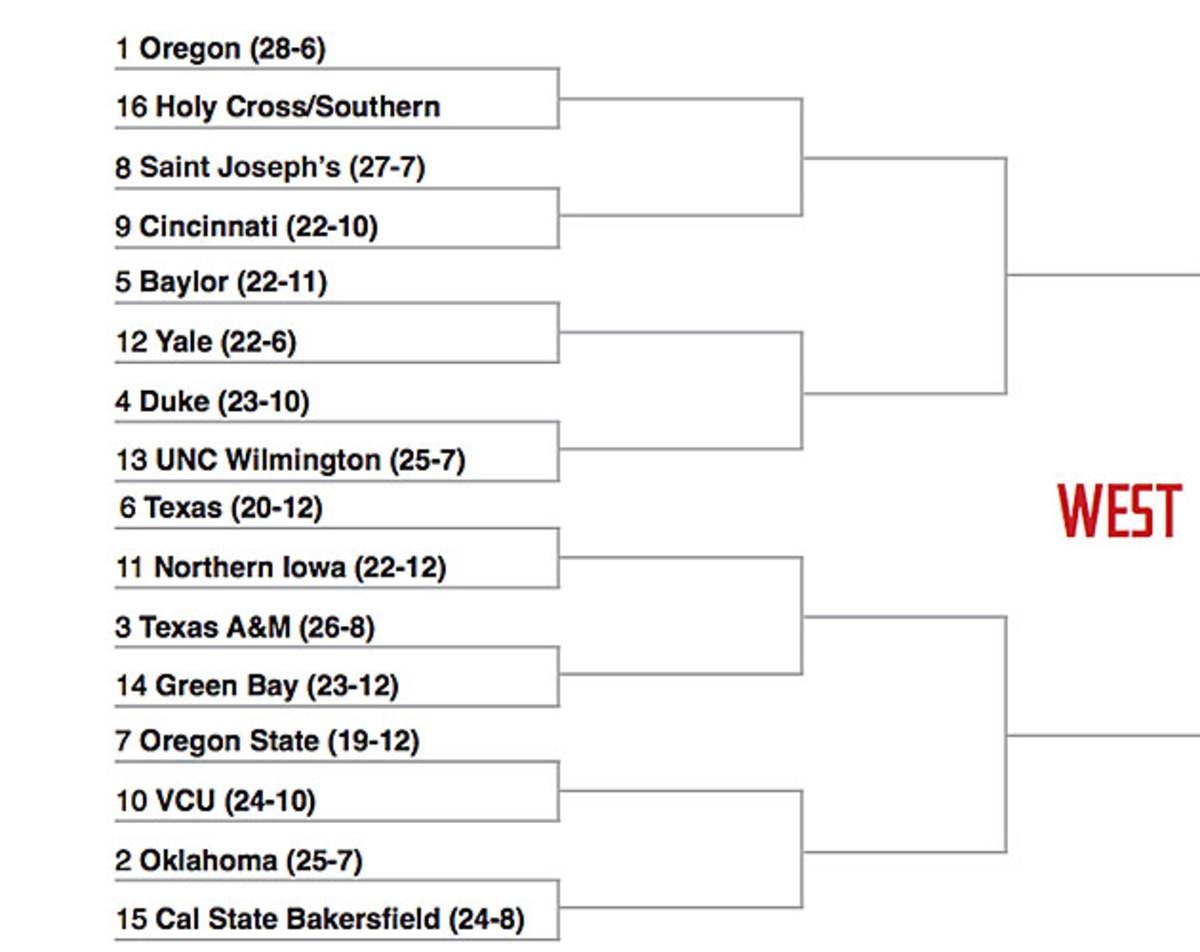NCAA tournament: Can Oregon ride momentum to win the West?

STATE OF THE NO. 1 SEED
Fairly ecstatic. Not only does Oregon roll into the NCAA tournament after following its outright Pac-12 regular season title with an emphatic run to the league tournament championship, but the Ducks also weren’t a victim of West Coast bias and kicked down to a No. 2 seed by Michigan State or Villanova. They got exactly what they wanted and likely deserved. Oregon was 6–1 against Arizona, Utah and Cal, the only other truly formidable teams in the league. The league tournament final turned into a bloodbath, with the Ducks beating Utah by 31 for their eighth straight win. This is a team that suffered mind-boggling non-conference losses (UNLV? Boise State?) yet appears now to be Final Four material and capable of beating anyone.
The offense is the biggest reason for that. It’s the fifth-most efficient attack in the country, per kenpom.com, with four double-digit scorers, all of whom shoot better than 45% from the floor. Sophomore guard Dillon Brooks came into his own as a star especially during Pac-12 play, when he averaged 17.1 points per game and shot 52.3% on his two-point attempts. And if coach Dana Altman’s crew isn’t exactly the stingiest around, it can make impact plays to stifle another team’s rhythm: Oregon ranks 21st nationally in steals (259) and second in blocks (201), led by 6'10" forward Chris Boucher’s 3.1 swats per night. There will be staunch challenges as soon as the second round, but Oregon seems as equipped as possible to handle them.

• MORE: The field is set for the 2016 NCAA tournament
UPSET PICK
No. 13 UNC Wilmington over No. 4 Duke
Of the 68 teams in the NCAA tournament, 13th-seeded UNC Wilmington plays the 14th fastest, according to the kenpom.com tempo numbers. The Seahawks are only a fraction slower than Oklahoma in fact—70.7 possessions per game to the Sooners’ 70.8—and first-year coach Kevin Keatts runs out eight players who average at least 12 minutes per game. A fairly deep team that can push tempo and put some numbers on the board (79.2 points per game) … that is a fairly decent recipe for upending a wobbly Duke team in a region that doesn’t abound with upset possibilities.
UNC, Kansas, Virginia, Oregon earn No. 1 seeds in NCAA tournament
Duke will have rested its very limited rotation after an exit in the ACC tournament semifinals, and you can already imagine Mike Krzyzewski & Co. dropping into a zone and daring a team that shoots 33.6% from three-point range to beat it that way. But UNCW has three double-digit scorers, led by 6'5" guard Chris Flemmings (16.1 PPG), and a bunch of other bodies to throw at the Blue Devils. Again: The West doesn’t look to be crawling with first-round upset possibilities. But if you’re sizing up teams most vulnerable to unexpected exits, you might look here first.
• SI bracket challenge: Make your tournament picks here
SLEEPER TEAM
Handicapping fifth-seeded Baylor’s chances to advance in an NCAA tournament, especially based on past results, can induce headaches. Elite Eight in 2010 … and missed the tournament entirely the next year. Elite Eight in 2012 … and NIT the year after that. Sweet 16 in 2014 … and a round of 64 defeat last season. Since it’s an even-number year, it must mean the Bears are destined to make a run, no?
NCAA tournament: Can Kansas navigate through the South?
They seem positioned to do so, anyway. Duke will be rested but vulnerable as a possible second-round opponent, especially given the Bears’ depth—nine players appeared in 31 or more games this year—and the length and beef throughout the rotation. (Baylor runs out five players 6'5" or taller, with 6'8", 280-pound rebound machine Rico Gathers manning the paint.) Should Baylor meet Oregon in the Sweet 16, the Bears’ offense (13th nationally in efficiency) can match the firepower of the Ducks. As usual, there is enough raw material here to do damage. As usual, expecting the Bears to make noise is a year-to-year thing.
• ELLIS: Kentucky exacts revenge on Texas A&M to win SEC tournament
PLAYER TO WATCH
Isaiah Cousins, Oklahoma. When things were going spectacularly well for the Sooners, Cousins was shooting 46.8% from three-point range and serving as the chatty, granular yang to the effervescent Buddy Hield’s yin. Since a 21-point effort in a loss to Kansas on Feb. 13, though, the 6'4" senior has dipped a bit on the offensive end. He’s averaged 10.4 points per game in that stretch after averaging 13.6 before it. He’s shooting just 35% from the floor since mid-February and 10 of 31 from long range in his last eight outings. The efficiency hasn’t been there in the way it was earlier this season and perhaps it’s therefore no surprise that the Sooners went 5–3 down the stretch.
To recapture the incredibly good vibes Oklahoma was riding through the early part of February, Cousins has to recapture his offensive form from that time. Hield will need help if the Sooners are to make the Final Four run that seemed predestined not too long ago. Cousins can provide that help. His effectiveness will determine if Oklahoma can heat up again, or if it will merely flame out in March.
